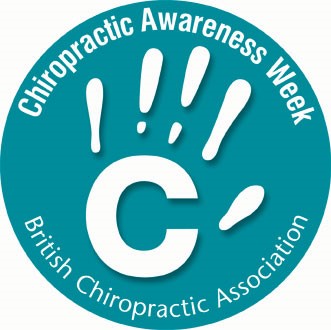![]()
Happy Easter
We welcome Jenny back to the team after her maternity leave and thank Wendy for holding the fort. Jenny still has a few appointments available before Easter so give reception a ring to get in quick for your sports massage.
We focus on Chiropractic Awareness Week (8th – 14th April) and find out how to keep back pain in check in the East Midlands.
Essential maintenance work will be carried out this month on the roof and to rebuild our car park wall, so please be extra vigilant when you get your text reminders as we will let you know if the car park is closed or restricted during your treatment session.
Alex jets off to Turin in Italy for a cranial conference, after representing the Royal College of Chiropractic at the national breast feeding conference at Leicester University '#IT'S NORMAL'. She will be sharing the impact chiropractic care can have on supporting mums and babies. We'll find out how she gets on next month.

People in the Midlands encouraged to stay active this Chiropractic Awareness Week
British Chiropractic Association (BCA) discovers half of people in the Midlands fail to prevent or manage back pain
This Chiropractic Awareness Week (8th – 14th April) the BCA is encouraging people in the region to keeping moving, after finding that 47% of people in Midlands don’t take any steps to look after their back health.
The findings come from a survey conducted by the BCA, which unearthed that 21% of people in Midlands don’t take any action when they experience back or neck pain and 11% wouldn’t seek help from a health professional if they were experiencing these issues.
Chiropractic Awareness Week aims to educate people about the easy ways they can avoid or alleviate back pain, which over 80% of the nation suffers with. Regularly changing posture and remaining seated for no longer than 30 minutes at a time are just a couple of the simple ways to prevent or reduce pressure on the back.
According to the BCA’s survey, when it comes to back and neck pain, they found that people in Midlands:
- 47% don’t take any steps to look after their back health
- Only 53% have taken preventative steps to protect themselves from developing back or neck pain
- 79% have experienced back or neck pain
- 11% wouldn’t seek help from a health professional for back pain and, 32% would wait a month or longer
- Only 8% would make changes to their daily routine if experiencing back or neck pain
- 16% choose their mattresses bases on price, rather than comfort
The BCA’s top tips for keeping on top of neck and back pain include:
- Keep on moving: Physical activity can be beneficial for managing back pain, however it’s important that if this is of a moderate to high intensity that you warm up and down properly to get your body ready to move! If a previous injury is causing you pain, adapt your exercise or seek some advice. Activities such as swimming, walking or yoga can be less demanding on your body, while keeping you mobile!
- Take a break: When sitting for long periods of time, ensure you stand up and move around every 30 minutes. When at work, also make sure your desk is set up to support a comfortable position. This is different for everyone so if you don’t feel comfortable in your current set up, try altering the height of your chair or screen.
Other things which people can bear in mind include:
- Lifting and carrying: Remember to bend from the knees, not the waist when lifting heavy items. Face in the direction of movement and take your time. Hold the object as close to your body as possible, and where you can avoid carrying objects which are too heavy to manage alone, ask for help or use the necessary equipment.
- Sleep comfortably: The Sleep Council recommends buying a new mattress at least every 7 years. Mattresses lose their support over time, so if you can feel the springs through your mattress, or the mattress is no longer level, your mattress is no longer providing the support you need. Everyone has different support requirements, so when purchasing your mattress ensure it is supportive for you. If you share a bed and require different mattress types, consider two single mattresses which are designed to be joined together, to ensure you both get the support you need.
- Straighten Up!: The BCA has created a programme of three-minute exercises, Straighten Up UK, which can be slotted in to your daily schedule to help prevent back pain by promoting movement, balance, strength and flexibility in the spine.

Easter getaway?!
It’s the Easter school holidays and, whether traveling for a longer break, taking a last minute weekend trip or just a day out with the kids, if you are going to be spending some serious time in the car, look at our top tips to help keep your back in shape.
Make adjustments
– If you share a car, make sure the seat position is adjusted to suit you each time you get in.
– The back of the seat should be set slightly backwards, so that it feels natural and your elbows should be at a comfortable and relaxed angle for driving.
Steering wheel
– Once you have adjusted your seat correctly, your hands should fall naturally on the steering wheel, with just a slight bend in the arms.
If the wheel is too high and far away, tension will build up in your shoulders and upper back. If it is too low and close to you, the wheel may be touching your legs, which will reduce your ability to turn it freely, putting strain on the wrists and the muscles of the upper back.
Mirrors
Your reactions must be quick, so you should not need to move your head a lot. The mirror positions should allow you to see all around the car with the movement of your eyes with minimal head movement.
– Set your mirror positions to suit you before you drive off.
Seat belts
– Your seat belt should always lie across the top of your shoulder and never rub against your neck or fall onto the top of your arm.
– Depending on your height, you may need to adjust the position at which the seat belt emerges from the body of the car. (If the adjustments available are insufficient, it is possible to purchase clips that help you adjust your seat belt height without impairing safety.)
Footwear
– Once you have adjusted your seat correctly, your feet should fall naturally onto the pedals. You should be able to press the pedals to the floor by mainly moving your ankle and only using your leg a little.
– Avoid wearing wear high heels, or very thick-soled shoes, as you will have to over-extend the ankle in order to put pressure on the pedals. As well as making it much harder to deal with an emergency stop, this position will raise your thigh from the seat (reducing support to your leg) and create tension (and possibly cramp) in the calf. This, in turn, will impair the blood flow on a long journey.
Relax
– A relaxed driving position reduces stress on the spine, allowing your seat to take your weight.
– Take regular breaks – stop and stretch your legs (and arms!) at least every two hours, more often if possible. You should certainly stop more frequently if you are feeling any discomfort.
– Clench your cheeks – If you are stuck in traffic, exercise in your seat. Try buttock clenches, side bends, seat braces (pushing your hands into the steering wheel and your back into the seat – tensing and relaxing) as well as shoulder shrugs and circles.
– Leave the tight clothes at home – They will restrict your movement.
It’s all in the timing – Allow plenty of time for journeys to avoid stress.

Stress-free Exercise Tips
It is estimated that 80 million working days are lost in the UK each year due to stress.
Stress can be caused by more than just emotional challenges. It can also have a physical cause, for example, infections, allergies, extreme temperatures, environmental pollutants and even exercise can put pressure on the body.
Many people think of exercise as a stress reliever, however, our frame is designed for gentle exercise on a daily basis yet most people sit down all day. As a result, the muscles become weak, causing joint restrictions, back and other problems with the bones and joints.
When we do exercise, usually snatched during an hour from a busy schedule, it’s followed by days of inactivity. This approach may well increase the risk of back and joint problems.
Stress is quickly manifested in the muscles and bones and can lead to joint dysfunction, especially in the spine. This can also cause persistent headaches, migraine, neck and back pain.
Stress – Free Exercise Tips
- Always do warm–up exercises to avoid straining muscles
- Exercise for at least 30 minutes at least three times a week
- Wear the correct trainers to soften impact, particularly when jogging or running on hard surfaces
- Try and monitor your heart rate when exercising – it should rise to about 80% of its maximum; it is easy to calculate your maximum heart rate by deducting your age from 220, therefore, if you are 40 years old, your maximum heart rate should be 180 beats per minute, 60-80% of this is about 110 to 145 beats per minute
- Warm–down your muscles by doing gentle stretching moves

Do You Feel Dizzy For No Reason?
Most children get a real thrill out of making themselves dizzy. They’ll spin round and round as fast as possible and then collapse in a heap of laughter and giggles. However, when someone suddenly becomes dizzy for no apparent reason, it can be a very frightening and debilitating experience.
Dizziness is the third most common complaint in general practice, yet most people don’t know why it happens. Our eyes, ears and nerve endings in our joints all combine to send signals to the brain telling us where our body is in space. If these signals are interrupted or the wrong signals are sent, then we can get dizzy. There are a number of different reasons why we can feel dizzy. Some of these include more serious trauma to the head and/or neck.
People are sometimes confused between dizziness and vertigo. Dizziness can be described as a feeling of light-headedness, whereas with vertigo, you either feel as if the room is spinning or you yourself are spinning. By the age of 70, about 30 per cent of people have experienced vertigo it at least once. If you think that you have experienced vertigo, then it is best to seek medical advice.
We treat all conditions that affect any muscle or joint in your body, from your head to your little toe! One of the most common complaints that we treat is back pain and Chiropractic is recommended by the government authority, the National Institute for Clinical Excellence (NICE) for acute and chronic back pain. Some of the other conditions that we treat are neck and headache, shoulder pain, leg and hip pain, knee and foot pain, sciatica and arthritis. Our registered Chiropractors all have at least five years of training. Treatment costs can be covered through most health insurers. If you are in any doubt, we are always very happy to talk with you on the phone to see if your condition will respond well to Chiropractic treatment. Call the clinic now to arrange an appointment time that works for you. 0115 9225085 If you would like to opt-out of receiving these newsletters please follow the unsubscribe link below, email alex@beestonchiropractic.co.uk or let us know at your next appointment.




